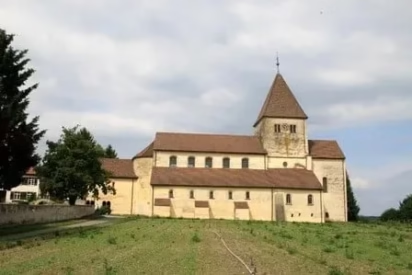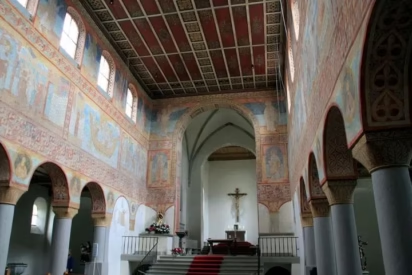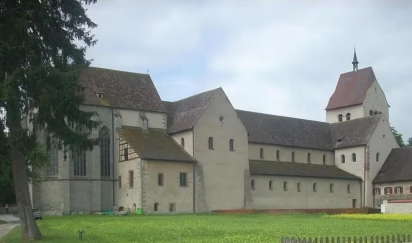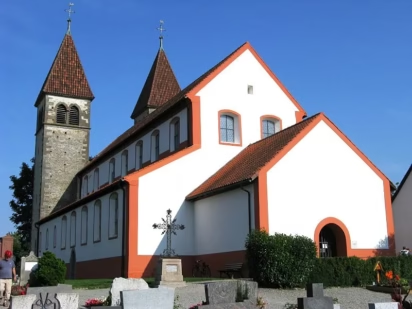Insel Reichenau in Lake Constance (Bodensee) on the German-Swiss border is home to three Romanesque churches with historically important wall paintings.
Reichenau Island near Konstanz in Germany is famous for its three magnificent Romanesque churches. A millennium ago, Reichenau was at the cultural heart of Europe with Kloster Reichenau monastery an important center of learning. The three Romanesque churches in Oberzell, Mittelzell, and Niederzell survived from this period and are inscribed in the UNESCO World Cultural Heritage list. Well-preserved wall paintings on Reichenau are amongst the oldest in Europe north of the Alps.
Romanesque Churches on Reichenau Island in Germany
Reichenau is a small island in the Untersee part of Lake Constance (Bodensee) on the Swiss-German border. Vegetal production is the mainstay of the modern economy but during the Middle Ages, Reichenau was an important cultural center.
The first Benedictine monastery in the German-speaking world was founded in AD 724 by Karl Martell as Kloster Reichenau. During the Carolingian period, and up to the early 13th century, Reichenau was an important center of learning. The monastery’s golden age was from the 9th to 11th centuries and the three Romanesque churches on the island date mostly from this period.
Romanesque Wall Paintings in St George in Oberzell, Reichenau
The triple-nave basilica of St Georg in Oberzell dates partly from the late 9th century and is considered one of the best examples of late Carolingian architecture. The Western apse and portal are from the 11th century while some of the Gothic elements are from the 15th century. The early-9th-century crypt can only be seen on guided tours.
The main reason to visit St Georg is to see the best examples of church wall paintings from this period in Europe north of the Alps. The very well preserved wall paintings that fill the entire nave date from before AD 1000. Most of these up to 2-m-high and 4-m-wide paintings illustrate miracles performed by Christ.
A small museum recently opened near the church. It is well worth visiting the museum first for an explanation of the history as well as close-up views of the reproduced paintings.
The Romanesque Minster of St Maria & St Mark in Mittelzell
Mittelzell is the largest town on Reichenau Insel and the Münster St Maria und St Markus is also the largest Romanesque church on the island. This is the original center of Reichenau monastery, which only formally disbanded in 1757.
The triple-nave basilica with double transepts dates mostly from the 11th century but the Gothic choir is from the 15th century. Some of the arches and parts of the transept are the original constructions consecrated in 816. The oak roof rafters, left exposed since 1970, are around 700 years old. They remind of an inverted ship and are typical of the period.
Several relics and reliquaries are preserved in the small treasury (Schatzkammer). The most important is the St Mark relic that came to Reichenau Island in 830.
Several further former monastery buildings and a monastery herb garden can be seen nearby. The local history museum is a few blocks away near the Reichenau tourist information office.
The Romanesque St Peter & Paul Church in Niederzell, Reichenau
The former abbey church Stiftkirche St Peter und Paul is based on foundations of a church originally consecrated in 799. The current triple-nave, twin-towered basilica dates mostly from the 11th and 12th century but its interior is mostly in the more modern Rococo style of the mid-18th century.
However, the most important artwork in the church is an early 12th-century wall painting of Christ and the apostles.
A small museum next to the church explains the history of the abbey church as well as some of the architectural elements.
Visiting the Churches and Museums on Reichenau Island
The three museums on Reichenau Island are open April to October from Tuesday to Sunday from 10:30 am to 4:30 pm (5:30 pm in July and August). From November to March, the museums are only open weekends from 2 to 5 pm.
The treasury and Gothic choir in the minster are open from April to September, Monday to Saturday from 10 am to noon and 3 to 5 pm.
Transportation to Reichenau in Lake Constance, Germany
Getting to Reichenau is very easy by car as the island is connected by road to the mainland. Reichenau is only around 10 km from Konstanz – follow the B33 towards Radolfzell and Singen. Parking (small charge) is available near all three churches (pdf map of Reichenau Island).
Public transportation is available around once per hour from Konstanz. Take the train to Reichenau (Baden) and then continue by bus to Reichenau Island. Total traveling time is around half an hour. See German Railways for online timetables and train tickets.
Reichenau, and the whole Lake Constance area, is very popular with cyclists and hikers. The island is mostly flat and ideal for leisurely cycling.
During the summer season, pleasure boat cruises arrive from Konstanz (D) and Kreuzlingen (CH) and continue down the Rhine to picturesque Stein am Rhein and Schaffhausen with easy access to Rheinfall – the largest waterfalls in Europe.
St Gallen in Switzerland has a history closely intertwined with Reichenau but is mostly famous for its glorious Baroque library, which is also a UNESCO-listed property. The Romanesque painted wooden ceiling in the St Martin’s Church in Zillis near Chur is one of only three that survived in Europe and worth a detour. However, it is absolutely worth crossing the Alps to Müstair in the far southeastern corner of the Swiss canton Graubünden. The UNESCO-listed Convent of St John here has the most important cycle of Carolingian frescoes preserved in situ.



